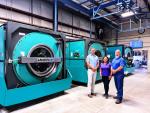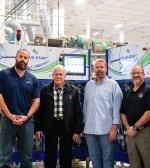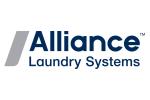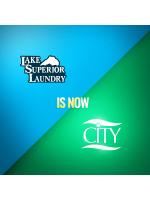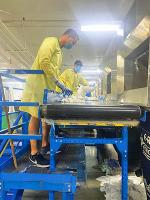ATLANTA — The laundry and linen services industry is in a race right now.
A race to “return to greatness,” according to Jay Juffre, executive vice president of ImageFIRST, a healthcare linen and laundry services provider headquartered in King of Prussia, Pennsylvania.
After the past couple of years, the industry is in a “time of tremendous opportunity.”
“It’s a race right now with a very limited window, and companies that were great prior to COVID who may have slipped a little have the opportunity to return to greatness,” Juffre says.
“Companies organizations that were just good or even poor have the opportunity to become the industry leaders.”
How can laundry operations win this race?
“The companies and organizations that reconnect with their employees, their customers and their cultures the quickest are going to win,” he says. “The others may not even place, and they may be left far behind.
“A winning culture not only makes a place a great place to work, but we know it fuels success, it fuels growth and drives results.
“Now more than ever, culture matters, and leadership and culture go hand-in-hand.”
Juffre shared how ImageFIRST’s culture and purpose have driven business development during the educational session “Building a Business on Culture” at The Clean Show here this summer.
THE GOLDEN CIRCLE
When Juffre first interviewed at ImageFIRST, the company was rolling out new operating principles. In the middle of a circle, the company’s purpose was why the team went to work every day. Around that core purpose were the company’s values (how they work), goals (how it “wins”) and service vision (how it connects with customers).
He saw that something was missing: no mention of linen, washing and drying, delivery, etc.
“If ImageFIRST could build a company and maintain these operating principles, they could be pretty special,” Juffre says.
About two years before he interviewed with the company, Juffre read “Start with Why” by Simon Sinek, which highlights a concept called The Golden Circle.
“Every single organization or company in the world can tell you what they do,” he shares about the concept. “They can tell you what they do. They can probably tell you how they do it. Very few can clearly articulate why they do what they do.
“What Simon figured out is for great organizations, almost every great organization, almost every great company, every great social or political movement, typically, starts from the middle and work their way up. They start with the why; they start with why they do what they do. Then they work with the how. And then finally the what.”
Juffre asks if laundry operators know their companies’ “why.” Can they define it, and does every member of the team know the “why” they go to work and have it top of mind every day?
THE IMAGEFIRST EXAMPLE
“ImageFIRST is not a perfect company,” Juffre admits. “We don’t have a perfect culture, but I will submit to you that our approach has delivered a good culture and some remarkable results that has fueled growth.”
He says that ImageFIRST does start with the why, the company’s purpose. The reason every single employee goes to work each day is to build a great company with positive impact on the lives of its associates, its community, its customers and their patients.
“What a great reason to go to work every day,” Juffre points out, “and we teach this at every level in the organization.
“To give you an example of how this can have an impact on our industry, take a production associate who’s focused on our plan. What am I doing? Feeding gowns into a small-piece folder. That’s a much different perspective than a production associate focused on why they are doing what they are doing.
“Why am I doing this? Soon patient will be wearing this gown. They’ll probably be in a doctor’s office or surgery center. They might receive good news or bad news while wearing it. Therefore, I’m going to take a little bit more time to inspect it. Big difference.”
Juffre then used the company’s customer advocates, who deliver goods, to show the difference between focusing on “why” rather than “what.”
“What are they doing?” he says. “They’re driving the truck, picking up soiled linen and delivering clean linen. As opposed to the why: I’m managing a winning program for my customers to make life easier for their staff so they can take great care of their patients.
“I could go on and on, but aligning your team around the why they go to work as opposed to what they’re doing can have a huge impact on how much pride they take in what they do.”
Juffre says that once the “why” is set, the company moves on to the “how.”
“One easy way to build a culture is to define the behaviors that you want people to act and then teach and reinforce those behaviors every single day,” he points out.
Then, the company focuses on its goals.
“This is how we win,” says Juffre. “Our goals, in order, are associates, customers, growth and then profit. Our No. 1 goal, it ties to our purpose, is for our associates to take pride in achieving their best.
“Followed by our customer goal; we want to create partnerships. We can’t live without our customers. Followed by our growth goal; we want to increase organic growth 12% or greater every year. Followed by our profit growth; we want to increase our profit year over year by 18%.”
Juffre admits that he does get “pushback” from others in the industry about the order of the company’s goals.
“They’ll say without profits, you can’t pay the associates,” he shares. “Without customers, there’s nothing for the associates to do. Without growth, you can’t sustain the other three goals. All I can say is we respectfully disagree.
“The customer will never be happier than the person taking care of them. If you don’t believe me, go to a coffee shop, and I’ll show you what I mean. If the server’s miserable, the customer’s miserable.
“Associates take great care of the customer. Then you build loyalty and loyalty leads to more customers and referrals. Our approach is simple: take great care of your people. Create an environment where they love coming to work each day. They, in turn, will take great care of the customer, and you will grow profit.”
ImageFIRST’s final “how” was added about five years after Juffre joined the company: how the company interacts with customers.
“Create a positive moment with every action,” he says. “We wanted a ‘how’ that can really support our values, our purpose and our goals.
“This is not only how we interact with customers; this is how we interact with everyone—our customers, their staff, their patients, each other, folks we meet out in our community, our vendors.
“And think about this, if every interaction you have with someone is positive, it’s nearly impossible not to have a positive impact on that person.”
Read the conclusion Thursday with Juffre’s advice for implementing service-based culture principles.
Have a question or comment? E-mail our editor Matt Poe at [email protected].



























































































